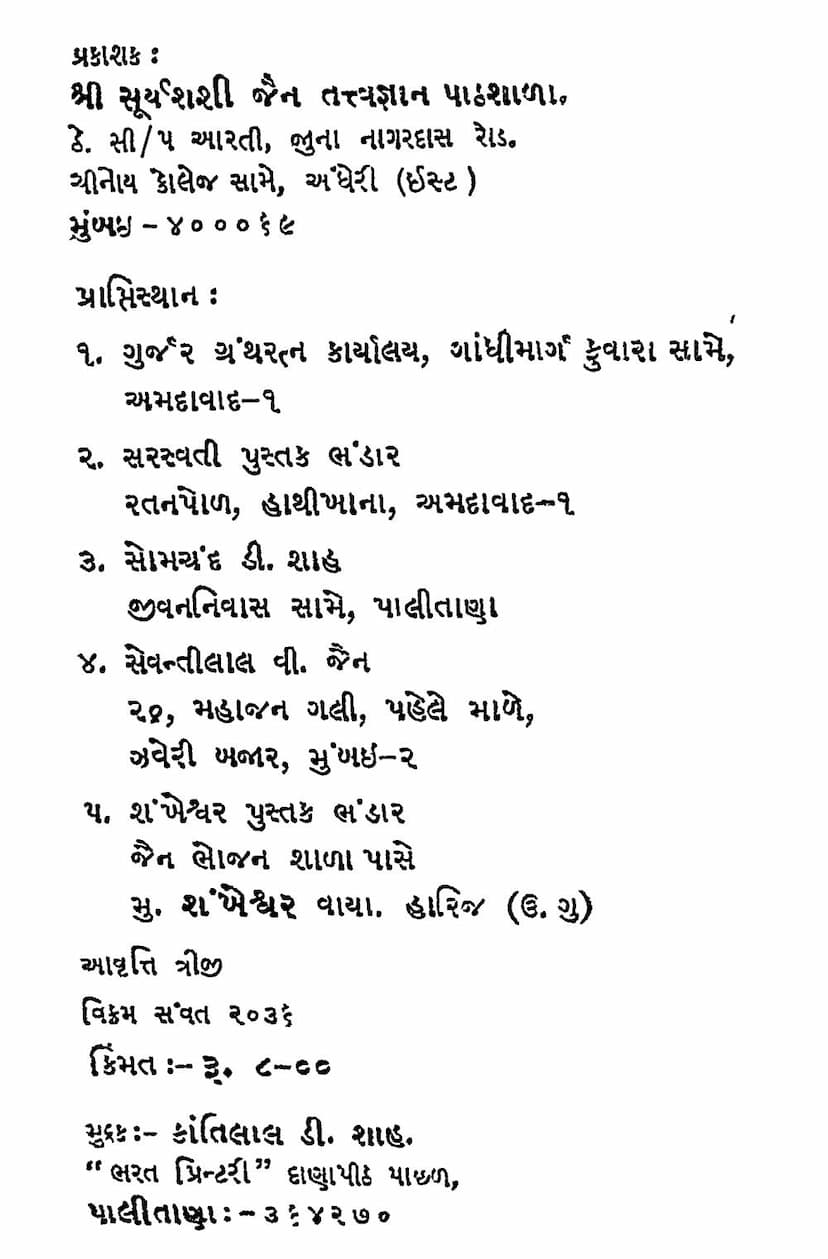Anupreksha Kiran 01 02 03
Added to library: September 1, 2025

Summary
Here's a comprehensive summary of the Jain text "Anupreksha Kiran 01 02 03" by Suryashashi Jain Tattvagyan Pathshala, based on the provided Gujarati content:
Anupreksha Kiran 01 02 03: A Summary
This collection, "Anupreksha Kiran 01 02 03," published by Suryashashi Jain Tattvagyan Pathshala, is a profound exploration of the significance and practice of the Navkar Mahamantra (Panch Parmeshthi Namaskar) in Jainism. The text emphasizes the mantra's central role in spiritual development, purity of mind, and ultimate liberation.
Core Themes and Teachings:
The central thesis of the book is the supreme importance of the Navkar Mahamantra (also known as Panch Parmeshthi Namaskar). It is presented as a divine seed containing the essence of the fourteen Purvas and the essence of all auspiciousness. The mantra is described as the "king of all mantras" and a powerful tool for spiritual growth.
Key Concepts Elaborated:
-
The Power of Namaskar:
- The mantra is credited with the power to destroy all sins, generate supreme merit, and lead the soul towards spiritual evolution.
- Unlike ego, which leads to destruction, "Namaskar" (humility, bowing down) guides the soul towards growth and perfection.
- Everything beautiful and auspicious in the world is attributed to the grace of Namaskar.
-
The Supremacy of the Panch Parmeshthis:
- The Namaskar mantra derives its power from the five supreme beings (Panch Parmeshthis): Arihants, Siddhas, Acharyas, Upadhyayas, and Sadhus.
- These Panch Parmeshthis are described as the ultimate auspicious, supreme, and refuge-worthy entities in this world.
- Understanding and realizing the essence of Namaskar and the Panch Parmeshthis is presented as the highest and ultimate duty of human life.
-
Spiritual Benefits of Reciting the Navkar Mantra:
- Mental Purity and Strength: The mantra develops the mind's power, helps conquer inner enemies like lust, anger, greed, ego, attachment, and aversion, and purifies the mental sheath.
- Character Development: It instills virtues like humility, truthfulness, purity, contentment, compassion, generosity, and gratitude. It eradicates harshness of speech, stinginess of mind, and ingratitude of intellect.
- Intellectual Refinement: Namaskar purifies and sharpens the intellect, making it subtle and capable of understanding profound truths.
- Spiritual Progress: The mantra is a catalyst for achieving knowledge, peace, and ultimately, union with the divine (Parmatma). It aids in understanding the cycle of birth and death, leading to detachment from worldly pleasures.
- Overcoming Obstacles: Reciting the mantra helps overcome negative tendencies, karma, and mental agitation.
- Divine Grace: It is believed to attract the grace of the Panch Parmeshthis, leading to auspicious outcomes.
- Physical and Mental Well-being: The text implicitly suggests benefits for physical health through mental purification and the practice of meditation.
-
Anupreksha (Contemplation) on the Mantra:
- The book emphasizes deep contemplation on the mantra's meaning and the virtues of the Panch Parmeshthis.
- It highlights that the mantra is not just a sequence of words but a profound philosophy containing the essence of Jain teachings.
- Different interpretations are offered for the syllables, linking them to various spiritual concepts like the fourteen Purvas, knowledge, virtues, and the three worlds.
-
The Mantra as a "Mahā Kriyā Yoga":
- The Navkar mantra is presented as a comprehensive practice encompassing various yogic principles:
- Tapas (Austerity): Both external and internal austerities are implied through the discipline of chanting.
- Swadhyaya (Self-study): Contemplating the meaning and virtues of the Panch Parmeshthis is a form of Swadhyaya.
- Ishwar Pranidhana (Surrender to the Divine): Surrendering to the Panch Parmeshthis is a core aspect.
- This "Mahā Kriyā Yoga" is seen as the means to overcome obstacles, achieve peace, and attain liberation.
- The Navkar mantra is presented as a comprehensive practice encompassing various yogic principles:
-
The Importance of Faith and Devotion:
- The text repeatedly stresses the need for unwavering faith (Shraddha) and devotion (Bhakti) in the Navkar mantra and the Panch Parmeshthis.
- These qualities are essential for experiencing the mantra's true power and benefits.
-
Practical Application:
- The book encourages consistent recitation and deep reflection on the mantra.
- It emphasizes integrating the mantra's principles into daily life, fostering qualities like compassion, forgiveness, and humility.
Structure of the Book:
The book seems to be divided into "Kirans" (Rays of light), suggesting a progressive unfolding of the mantra's teachings. The summary highlights the deep philosophical and practical aspects covered across these sections, focusing on how the Navkar mantra serves as a complete path to spiritual realization.
In essence, "Anupreksha Kiran 01 02 03" acts as a guide, illuminating the multifaceted power of the Navkar Mahamantra, urging readers to embrace its teachings for spiritual purification, ethical conduct, and the ultimate attainment of Moksha.